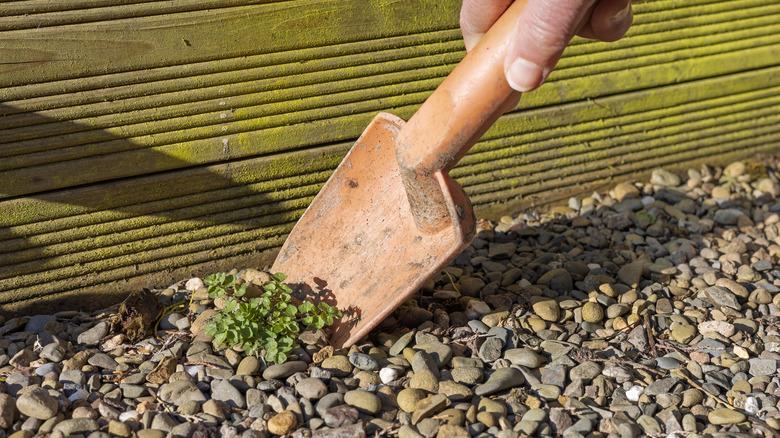Keep Weeds From Growing In Gravel With An Easy DIY Remedy
Gravel has long been lauded as a hardscaping tool that boosts visual appeal in a yard, and yet is incredibly easy to maintain. It doesn't require too much effort — you don't have to water it, thus making it a drought-tolerant alternative to lawn. It also deters pests, which means your plants need a little less TLC. Most importantly, gravel is known to suppress weed growth. However, every once in a while, it's not uncommon to have some unwanted, pesky weeds poking through the layer of rocks. Don't panic or lament that you made the wrong hardscaping choice though, the solution is an incredibly simple DIY: just add more gravel.
One of the reasons why you may be seeing weeds break through is because the gravel layer is too thin, therefore allowing unwanted growth. Ideally, your gravel cover should be as least 3 to 4 inches deep, evenly spread across the area, without gaps. It's still possible for tough weeds to find their way to the surface though, so every year, you should add another thin layer of gravel on top of your current spread to smother any weeds forming. Since it's possible for rocks to get moved, displaced, or disappear, adding that extra bit of gravel helps replace any loss and plug up spaces where the soil is exposed (and thus weeds can grow). Additionally, don't forget to regularly rake the gravel as well, since turning over the rocks and agitating them is a great way to disrupt weed growth.
What kind of gravel is best for weed prevention?
The best type of rock gravel for landscaping and weed prevention has a lot to do with how your space is used. Pea gravel, for instance, is a popular budget-friendly option, made up of small — you guessed it– pea-sized pieces of smoother rock that makes for a decent weed-matting option. Pea gravel has many pros and cons, however, so if you're planning on gravel in high trafficked areas like patios, it can get dislodged and move around easily, exposing baldness and leaving space for weeds. If you go this route, be sure to diligently add gravel when you see naked spots.
Alternatively, you can look to inexpensive construction gravel for frequently used spaces. This particular gravel's irregular measurements and shapes provide compact and stable ground coverage so you won't have to worry as much about rocks moving around and exposing the ground. The added benefit of construction gravel is its moderate cost as well. Since it'll be less likely you'll need large amounts to top up your gravel for that annual maintenance project, this option remains budget-friendly after installation.
Overall, you'll want to opt for gravel that is angular and compacts down nicely. This includes options like lava rock, brick chips, or crushed granite, all of which are frequently used in hardscaping. Rethink gravel with rounded stones, like river rock, since it's more susceptible to gapping given the stones' smooth edges and inability to compact together as optimally as angular alternatives.
Additional gravel tips to prevent weed growth
Beyond choosing the best gravel and adding more of it to your hardscape to prevent growth, there are some other great ways to keep pesky weeds from growing in gravel too. If you're just at the beginning stages of your gravel landscaping journey, for instance, consider using a landscaping fabric underneath the gravel to add an extra layer of suppressive material to ward weeds off. You can even add another layer of base material, like finely crushed stone, underneath your gravel for even more assurance that weeds can't get through.
It's also important to have a level ground and decent drainage to prevent weed growth with gravel landscaping, since pools of water are notorious breeding grounds for weeds. Furthermore, if your gravel pathways, beds, or driveways meets landscaping that requires watering, like lawns, consider watering as minimally as you can in the areas these materials touch to prevent weeds from migrating over to the gravel.
And to really cover all your bases with weed prevention techniques in gravel, add some polymeric sand to your rock cover to help fill the cracks and gaps between the stones. All in all, you'll find that with these tips and tricks, weed growth in the graveled parts of your yard will subside. Adding in and layering more gravel to your hardscaping is the easiest DIY remedy against weeds, but you'll surely win the battle if you choose the right stones and keep in mind these other hacks.


